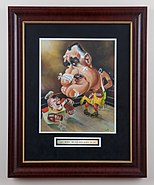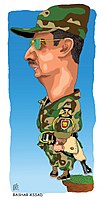Ranan Lurie
Ranan Lurie | |
|---|---|
 Lurie in 2013 | |
| Born | Ranan R. Lurie May 26, 1932 |
| Died | June 8, 2022 (aged 90) |
| Alma mater | Herzliya Hebrew Gymnasium |
| Occupation(s) | Cartoonist and journalist |
Ranan R. Lurie (
Biography
Ranan Lurie was born on May 26, 1932, the son of Shoshana (Shmuelewitz) and Joseph Lurie,[4] who had traveled from Tel Aviv to Port Said, Egypt, at the invitation of Joseph's father (Rabbi Isaiah Lurie) to give birth to their first child at his home. (This event gave him an advantage when he met with President Sadat (1977 and 1979) as well as with President Mubarak (1984 and 1997) for interviews and portrait-sittings). Two weeks after his birth Ranan and his parents returned to Tel Aviv. His father was sixth-generation Jerusalem-born and his mother seventh-generation.
Ranan Lurie's father was born in 1906, in the new neighborhood of "
Lurie was a member of the Israeli underground armed organization ("Irgun") and was wounded in a battle against the British. He later served in the IDF reserves as a Major and company commander.
In July 1954, when Israel and Egypt were still in an official stage of war, Lurie visited the flagship of an Egyptian navy flotilla anchoring in Venice, pretending to be an Australian journalist, he interviewed the frigate's high ranking enemy officers and took photographs of their newly installed Soviet Radar. Lurie described this as an infiltration and won an Israeli journalistic award "For Unprecedented bravery".
About a week before the Six-Day War began, Lurie had his fine-art exhibit in Montreal. He was recruited in the midst of his show to his reserve duty as a Senior Company Commander, a Major in the Fifth Brigade (Giv'aty) that was commanded by Colonel Ze'ev Shaham. Lurie's first mission was to protect Israel's "bottleneck" (the narrowest stretch of land between the sea and Jordanian
At the end of the war he gained a different kind of world attention when he refused to deport the Palestinian inhabitants of the town of Anabta to Jordan, risking a court martial which would have involved Prime Minister Levi Eshkol Lurie's friend. After meeting with Ranan the prime minister's friend[citation needed] Minister of Defense Moshe Dayan was instructed "to return immediately all the exiled Palestinian inhabitants and rebuild any of their destroyed homes". Defense Minister Dayan followed the order.[5]
Career
Lurie was the political cartoonist for
In 1964, the Prime Minister Levi Eshkol unveiled Lurie's one-man show of oil portraits at the "Sokolov House" in Tel Aviv, in the presence of Joseph Zaritsky, Reuven Rubin and Meiron Sima. On May 23, 1967, the President of Israel, Zalman Shazar, unveiled Lurie's one-man show of oil portraits at "Expo 67" in Montreal, Canada.

After
He is probably the only artist who has been invited simultaneously by both the
Lurie interviewed, painted, and drew more than 250 world leaders. His drawings often include a small trademark smiling sun, sometimes drawn on the subject's necktie or other articles of clothing.

Uniting Painting
He created his "Uniting Painting", the "Fine Art with a Mission", a contemporary art project that originated from the United Nations General Assembly Building in New York on October 24, 2005 (United Nations Day). It was the largest contemporary painting ever exhibited at the headquarters of the United Nations, measuring 75 feet (23 m) wide and 600 feet (180 m) long. The painting was so large that part of it was also exhibited on nearby Roosevelt Island for four years. Custom-painted extensions of the art were installed by the government of the Republic of Korea on the border between South Korea and North Korea (2006). Another "Uniting Painting" installation now orbits (on a satellite) earth, and simultaneously another three sections were brought by Sherpas to the summit of Mount Everest (April 19, 2011).[6]
Post-1984 career
Lurie became a
In 1984, he created Japan's national cartoon symbol, sponsored by Japan's Prime Minister
In 1985, he created Taiwan's national cartoon symbol, sponsored by Taiwan's Government.[8]
In 1985, he also started his year-long daily animated news cartoon on PBS' network (the

In 1993, John Brewer, the president of

At the beginning of 1996 Lurie created "Cartoon News", an educational magazine that taught current events by introducing mainly political cartoons supported by very short texts. Lurie, the editor in chief had about 60 cartoonists from all over the world working for it. The readership reached 600,000 within a short time.
About a year later, at the recommendation of the American Ambassador to Egypt,
Lurie was a member of Mensa.[9]
The United Nations/RANAN LURIE Political Cartoon Awards were created by former Secretary General Kofi Annan in 2000 and continued by Secretary General Ban Ki-moon. The award recognizes cartoons that "enhance, explain and help direct the spirit and principles of the U.N." The three first awards are worth a total of $18,000 and are distributed along with ten recognition plaques signed by the Secretary-General and Ranan Lurie.
On May 28, 1997, a plaza in Seoul, South Korea was named after Ranan Lurie, who has also received the "golden key to the city". Lurie was nominated by the
Family
He is the father of Rod Lurie, a West Point graduate who is a film director and screenwriter. His son Barak Lurie is a Stanford graduate and the Managing Partner of Lurie & Seltzer, a law firm headquartered in Los Angeles, also known for his radio show, "Lurie's Law"; His daughter Dr. Daphne Lurie is a Williams alumnus and the Directing Psychologist at the San Diego Scripps Research Institute. Danielle Lurie is a Stanford graduate and a movie director in New York.

Lurie lived in
Records
Lurie appears twice in the
Books
He published ten political cartoon books and one novel in five languages:
- AMONG THE SUNS—published by Israel's Air Force (Hebrew; introduction: Ephraim Kishon).[11]
- LURIE'S BEST CARTOONS FROM ISRAEL—printed by the N. Tversky Publishing House of Tel Aviv, Ltd., Israel (First Edition in Hebrew, Second Edition in English; introduction by Foreign Minister Aba Eban).
- NIXON RATED CARTOONS—printed by the New York Times publishing house (English; USA; foreword by Thomas Griffith, Editor of LIFE).
- PARDON ME MR. PRESIDENT—printed by the New York Times publishing house (English; USA; foreword by commentator Harry Reasoner and special comment by Vice President Gerald Ford).
- LURIE'S WORLDS—printed by the University Press of Hawaii (English; USA; foreword by Clare Boothe Luce).
- SO SIEHT ES LURIE (1980) -- printed by Welt Buch publishing house of Berlin (German; introduction by Ephraim Kishon).
- LURIE'S OPINION—printed by Zmorah Bitan publishing house of Tel Aviv (Hebrew; introduction by Shalom Rosenfeld, editor, Ma'ariv).
- LURIE'S ALMANACK—printed by Secker & Warburg, London (English; U.K.; introduction by Charles Douglas Home, editor, The Times).
- LURIE'S ALMANAC—printed by Andrews and McMeel publishing house of Kansas City-New York (English; USA; foreword by Charles Douglas-Home).
- MR. TARO SAN'S POLITICS—printed by Shinchosha Co. (Japanese; Tokyo).
In 1985, Lurie created an electronic cartoon animation technique that brought his cartoons to PBS stations and ABC network.[2]
In 1995, Lurie co-invented an automobile braking system that has a variable light and sound warning, registered as American Patent 5481243.[12]
- Gallery of Ranan Lurie cartoons
-
Current news cartoon: Barack Obama President of the United States, November 2014
-
2014 Crimean crisis.
-
"Don't worry - we have more gloves for you".
First published in LIFE magazine, 1968, showing President of Egypt, Gamal Abdel Nasser, recovering from Six-Day War results. -
Bashar Assad, becoming Syria's president, 2000.
-
The Uniting Painting onEverest
-
The Uniting Painting
References
- ^ Ranan Lurie – RIP
- ^ a b Ranan R. Lurie, CSIS
- ^ Cartoonews Archived June 11, 2013, at the Wayback Machine
- ^ a b "Ranan Lurie, Political Cartoonist With a Global Pen, Dies at 90". The New York Times. May 26, 1932. Retrieved June 14, 2022.
- ^ Dafna Linzer, Arab Expulsion Ended by Cartoonist, Associated Press, June 5, 1998
- ^ a b Taking Art to New Heights – Mt. Everest, NBC, October 9, 2009
- ^ The UNITING PAINTING: The World Is Its Canvas, LurieStudios
- ^ Cartoonist Ranan R. Lurie Searches For 'Chinese Symbol', Taiwan Today, July 28, 1985
- ISSN 0025-9543.
- ^ Hughes, C.J. (March 5, 2013). "Eye Candy, Structural and Natural". New York Times. Retrieved March 12, 2013.
- ^ Israeli Air Force site (Hebrew)
- ^ Who's Who of American Inventors 1996–1997, Fourth Edition, Hooper Group Publishing
External links
![]() Media related to Ranan Lurie at Wikimedia Commons
Media related to Ranan Lurie at Wikimedia Commons









